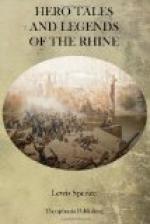Abeling and Boer, the most recent protagonists of the historical theory, profess to see in the Nibelungenlied the misty and confused traditions of real events and people. Abeling admits that it contains mythical elements, but identifies Siegfried with Segeric, son of the Burgundian king Sigismund, Brunhild with the historical Brunichildis, and Hagan with a certain Hagnerius. The basis of the story, according to him, is thus a medley of Burgundian historical traditions round which certain mythological details have crystallized. The historical nucleus is the overthrow of the Burgundian kingdom of Gundahar by the Huns in A.D. 436. Other events, historical in themselves, were torn from their proper epochs and grouped around this nucleus. Thus the murder of Segeric, which happened eighty-nine years later, and the murder of Attila by his Burgundian wife Ildico, are torn from their proper historical surroundings and fitted into the story. Boer, on the other hand, will not have it that there is any mythology at all in the Nibelungenlied, and, according to him, the nucleus of the legend is an old story of the murder of relatives. This became grafted on the Siegfried legend according to some authorities, but Boer will not admit this, and presents a number of arguments to disprove the mythical character of the Siegfried story. The reasoning is ingenious, but by no means valuable. We know that the mythologies of the ancient Germans and the Scandinavians were in many respects, though not in all, one and the same system, and we find many of the characters of the Nibelungenlied among the divine beings alluded to in the Edda. It is unlikely that the dramatis personae of a German murder story would find its way into even the most decadent form of Scandinavian belief. There is every reason to conclude that a great many historical elements are to be discovered in the Nibelungenlied, but to discount entirely those which are mythical is absurd and even more futile than it would be to deny that many of the incidents related in the great epic reflect in some measure historical events.
The Klage
The Klage, a sequel to the Nibelungenlied, recounts somewhat tamely the events which follow upon the dire catastrophe pictured in the great German epic. It is on the whole more modern than the Lied, and most critics ascribe it to a period so late as the fourteenth century. It is highly artificial and inartistic, and Grimm points out that it is obvious that in penning it the author did not have the Nibelungenlied, as we know it, before him. As it is practically unknown to English-speaking readers, a resume of it may not be out of place here. It describes the search among the dead bodies in the house of slaughter, the burying of them, the journey of Etzel’s “fiddler,” Swemmelin, to the Rhine by way of Bechlarn and Passau to give the tidings of the massacre to Queen Brunhild, his return, and the final parting from Etzel of Dietrich and his wife Herrat, who also take Bechlarn on their




